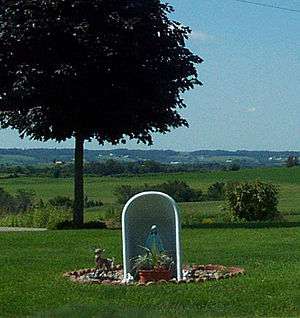Bathtub Madonna

A bathtub Madonna (also known as a lawn shrine, Mary on the half shell, bathtub Mary, bathtub Virgin, and bathtub shrine) is an artificial grotto typically framing a Roman Catholic religious figure.
Variations
These shrines most often house a statue of the Blessed Virgin Mary but sometimes hold the image of another Catholic saint or of Jesus. Infrequently, more than one figure is represented (as in this tableau of a juvenile Mary with her mother).
While often constructed by upending an old bathtub and burying one end, similar designs have been factory produced. These factory produced enclosures sometimes have decorative features that their recycled counterparts lack, such as fluting reminiscent of a scallop shell.
The grotto is sometimes embellished with brickwork or stonework, and framed with flowerbeds or other ornamental flora. The inside of the tub is frequently painted a light blue color, particularly if the statue is of Mary because of her association with this color. Over time, distinguishing characteristics of these shrines can become blurred. Instances occur of shrines whose statue is missing and conversely of grottoes being removed, leaving a statue in place.
Locations

Bathtub Marys in actual bathtubs are frequently found in the Upper Mississippi River valley, but was invented by Azorean Portuguese of New Bedford, Ma and Fall River, Ma but is also found in western Wisconsin, eastern Iowa and Minnesota, and are an important part of the visual folk culture of Roman Catholics in that region. Noteworthy concentrations of bathtub Madonnas can be found in Stearns County, Minnesota, an area heavily settled by German-American Catholics in the mid-19th century, the Holyland in eastern Wisconsin, and rural Bay City, Michigan.
Bathtub Madonnas are also a common sight in north-central Kentucky and southern Indiana, an area that has historically been predominantly Catholic. A drive down country roads in Nelson, Marion, and Washington counties will provide ample sightings of these small shrines.
In the Southern United States, bathtub Marys are a regular sight in the Cajun portion of South Louisiana, especially along the Bayou Teche. Breaux Bridge, St. Martinville, Port Barre, Cecilia, Baldwin and other communities along the bayou have examples of this type of shrine. They are also commonly found in the Baltimore, MD metropolitan area, and this prevalence was lampooned in the John Waters film Pecker.
Google and magazine database searches reveal instances of bathtub shrines among other Catholic ethnic groups in other locations, e.g., Mexican Americans in Milwaukee, Italian Americans in Michigan, and Hispanic Americans in New Mexico, French Catholics in Quebec, and in the heavily Polish-Italian-Irish Catholic region of northeastern Pennsylvania, particularly around Scranton.
In the northeastern United States, smaller shrines that do not make use of actual bathtubs are more common. Somerville, Massachusetts, a city which has traditionally had sizable Italian, Irish, Portuguese and (more recently) Brazilian populations, has over 350 Catholic yard shrines in a town of about four square miles, with more than 40 in actual bathtubs.[1]
See also
Notes
- ↑ Bathtub Marys of Somerville.
Further reading
- "For the Love of Mary—Yard Shrines Honoring Blessed Virgin Have Devoted Following", St. Cloud Visitor (Newspaper of the Roman Catholic Diocese of St. Cloud, Minnesota), August 16, 2001.
- Miyazaki, Kevin J. (January 2003). "Our Town". Milwaukee Magazine 28 (1): 20. ISSN 0741-1243.
- Perera, Srianthi (22 April 2006). "Grave Images Illuminate 150-year Tradition". The Arizona Republic. p. CR-18.
- Smith, Peyton (2003). "Grottos of the Midwest: Religion and Patriotism in Stone". Retrieved 2009-04-01.
- Sciorra, Joseph (1989). "Yard Shrines and Sidewalk Altars of New York's Italian-Americans". Perspectives in Vernacular Architecture (Vernacular Architecture Forum) 3: 185–198. doi:10.2307/3514304. ISSN 0887-9885. JSTOR 3514304.
- Graham, Joe S. (1997). Hecho En Tejas. p. 229. ISBN 978-1-57441-038-9.
- Nevans-Pederson, Mary (7 June 2008). "Shrine shift?". Telegraph Herald (Dubuque, IA). Archived from the original on 26 May 2011. Retrieved 2 April 2009.
- Ford, Suzanne (1994). Bathtub shrines : a stylistic, iconographic, and contextual analysis. Thesis (M.A. in Art History). University of Wisconsin—Milwaukee. OCLC 32691656.
External links
| Wikimedia Commons has media related to Bathtub Madonna. |
- A Creole yard shrine in Louisiana
- Front Yard Shrines and Wayside Shrines
- The Grotto of Unyang Pusan, South Korea
| ||||||||||||
